Diseases of the musculoskeletal system in almost all cases are accompanied by dysfunction of its organs, which causes great discomfort to the patient.
An important symptom of musculoskeletal pathologies is pain. Joint injuries are particularly unpleasant.
The hip is the largest of these. The pain in case of defeat can be located both around him and give him in various anatomical structures: in the organs of the small pelvis, in the lower back or in the thigh.
General classification of causes
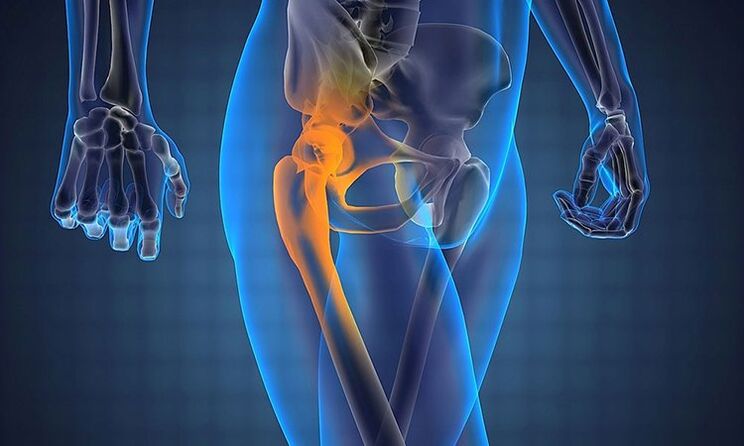
The etiology of hip pain is varied.
In medicine, the following causes of arthralgia are conditionally distinguished:
- Inflammatory and infectious processes inside the joint and in the surrounding tissues.
- Degenerative diseases of the musculoskeletal system.
- Injuries.
- Bone and soft tissue neoplasms.
There are additional specific causes of arthralgia:
- Piriformis syndrome. It is associated with prolonged spasm.
- Necrosis of the femoral head (GBC). Most often it is a complication of another pathology of TBS.
- Legg-Calve-Perthes disease. It is GBC osteochondropathy.
- Anatomy of osteochondrosis. In different sources it can be called Koenig's disease.
- Diabetic osteoarthritis. Complication of diabetes.
- Pseudo-urinary arthritis. Also chondro calcification.
- Intermittent hydrothorax is an overproduction of synovial fluid.
- Articular chondromatosis (Lotsch syndrome).
Also, the leg in the hip joint area in pregnant women often hurts.
During this period, complex hormonal changes occur, the developing uterus displaces adjacent organs and strains the ligament apparatus of the hip joint. In addition, weight gain increases the load on the legs. If the dietary recommendations are not followed, a pregnant woman may experience calcium deficiency, due to this metal imbalance, the structure of bones and joints is disturbed.
Causes of pain
The prevalence of arthralgia increases with age.In children, the symptoms of TBS (hip joint disease) occur with a frequency of not more than 10%, and in the elderly - from 50%. Mostly women suffer from this pathology. This is due to age-related hormonal changes after menopause.
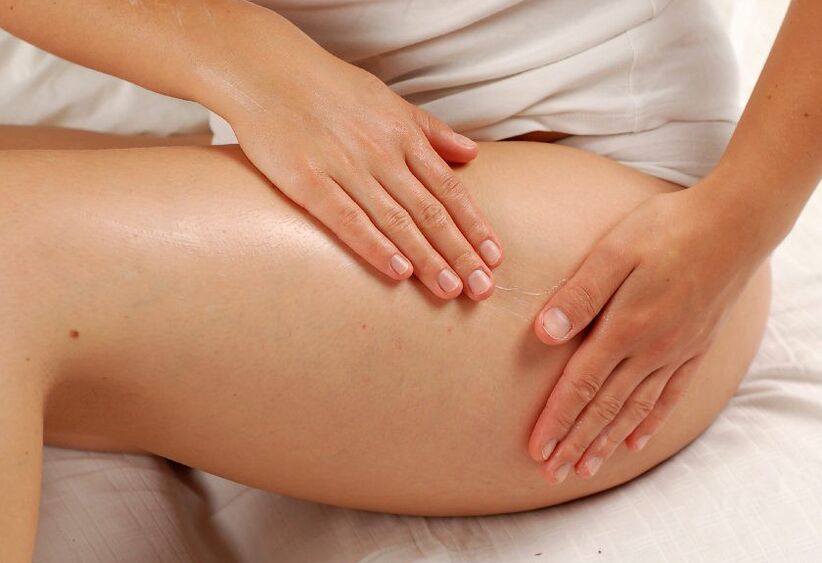
Why does the hip joint hurt? There is no clear answer to this question, since the list of reasons is quite large.
The main factors that cause arthralgia in the hip joint:
- Pathological process inside the musculoskeletal system. Most often, this is a consequence of immediate mechanical action: bruising of the joint with subsequent inflammation of its components.
- Anatomical changes in the joint. They can be congenital or post-traumatic (dislocations, fractures).
- Pathology of other systems. Inflammation of the organs of the MT (small pelvis) can spread to the bones of the pelvis. Neurological disorders are manifested by pain of any localization. Metabolic disorders cause metal imbalance. The bone-ligament connection weakens, the risk of injury increases.
Inflammatory and infectious processes in the joints and surrounding tissues
The most common cause of arthralgia of any location is the perforation of the musculoskeletal joint.
Inflammation of the hip joint is classified into:
- Primary. Formed by direct penetration of pathogens into the joint: blow with a sharp or blunt object with wound formation.
- Secondary. TBS infection occurs from a distant source of inflammation: by contact or by hematogenous route.
Arthritis TBS
It occurs mainly in elderly patients.Pain in the hip joint, which is aggravated by walking, radiates to the groin, perineum and thigh. It is difficult for the patient to get up from a chair or climb stairs without assistance. Annoyance worse in the morning.
Treatment includes taking anti-inflammatory drugs and the introduction of glucocorticoids into the intra-articular thorax. If necessary, the cavity is drained.
Rheumatoid arthritis (RA)
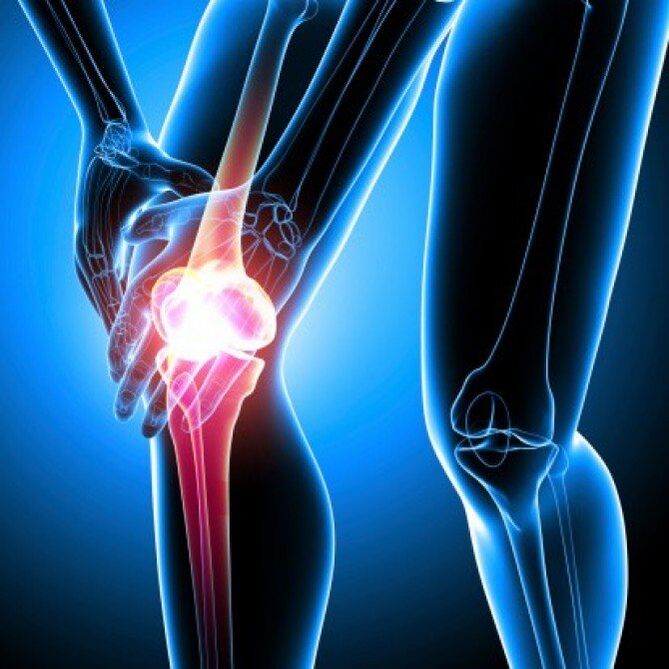
It is a chronic systemic connective tissue disease similar to polyarthritis.The essence of this pathological process is the inflammation of the synovial membrane, cartilage and joint. The reason is a malfunction of the immune system. Characterized by polyarthralgia, stiffness of movements in the morning, high fever is possible.
The shoulder and hip joints are extremely rarely affected, the pain only appearing at a late stage of RA after a few years from the onset of the disease.
Acute septic arthritis
It is an infectious childhood disease, 70% of cases occur in babies under 4 years old. The causative agent is usually Staphylococcus aureus. The child refuses to walk due to severe pain in the hip joint and groin when moving. It is characterized by high fever and increased excitability.
Treatment includes removal of the collection from the joint cavity and antibiotic treatment.
The risk of developing osteomyelitis and sepsis is high.
Tuberculous coccitis or arthritis
Most often, pediatricians treat this disease. In young children, the immune system is underdeveloped, which leads to the possibility of infection.
This disease is characterized by slow progression. Initially the child gets tired very quickly, his activity decreases, he stops running. Gradually, atrophy of the thigh muscles occurs. Movements are blocked. The pain in the hip joint in a child acquires an intense pain, the limb becomes longer than a healthy one.
If the pus melts the synovial membrane, then the exudate spreads along the muscles and tendons, forming phlegms and fistulas.
In the absence of complications, conservative treatment is performed.
Tendonitis in the area of the hip joint
This pathology is an inflammation of the tendon of the muscle and its vagina. Caused by prolonged abuse or injury to the foot.
The main complaints: the femoral joint hurts when moving, the lesion swells, change in gait - lameness is felt.
Treatment - medication: anti-inflammatory drugs, intra-articular injections of corticosteroids.
Bursitis
Of all the articular sacs, the acetabular sac is the most commonly inflamed.It partially covers the femur. With hip bursitis, the pain radiates to the thigh and gluteal area. The patient can not lie on the affected side: the pressure in the joint sac increases and the pain intensifies.
If there are no complications with bursitis, then the treatment consists of unloading the lower limb with a cane or crutch.
Medications: Painkillers and corticosteroids.
Idiopathic ankylosing spondylitis
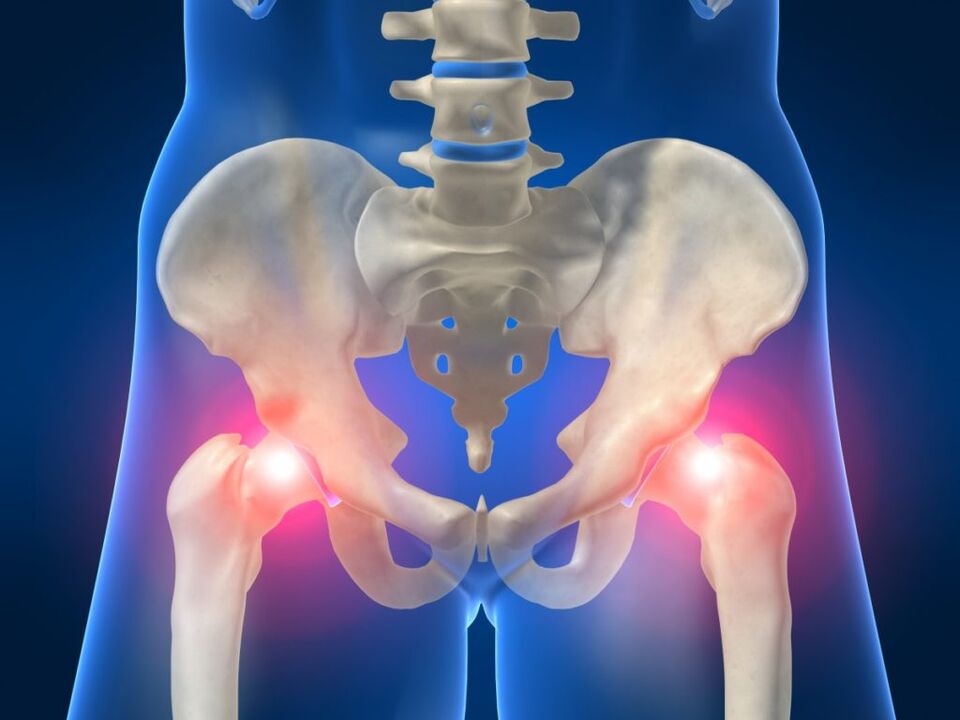
It is a chronic inflammation of the spine and elements of the sacroiliac joints.
The disease is dangerous for its complications that reduce the standard of living and lead to disability.
If you find such a problem, you should immediately contact a specialist to prescribe the right treatment.
The reason is not entirely clear. Modern medicine suggests that the main cause is hereditary predisposition. Most often, people under the age of 30 get sick.
Symptoms of idiopathic ankylosing spondylitis:
- Elevated body temperature, fever.
- Intoxication syndrome: general malaise, weakness, lack of appetite, weight loss, sleep disturbance.
- Persistent dull pain in the hip joint, as well as at the level of the sacrum and buttocks, which spreads along the back of the thigh. Usually on both sides, at night their intensity increases.
- Limited mobility in the lower back and hips. This symptom gradually spreads to the overlying parts of the spine along the entire back, including the neck. As a result, the patient assumes a forced "petitioner pose. "
Rehabilitation therapy is based on special physiotherapy exercises for the development of the joints.
Medications: NSAIDs to relieve pain and inflammation, corticosteroids.
Tendonitis
Athletes or people whose work is associated with heavy physical work are prone to tendonitis. Characteristic of the manifestation: the pain in the hip joint appears with a large load on it. At rest, there is usually no discomfort.
It is recommended to reduce the load on the leg, in advanced cases - bed rest.
Medication: NSAIDs, topical analgesic gels, glucocorticosteroids, chondroprotectants.
Syphilis
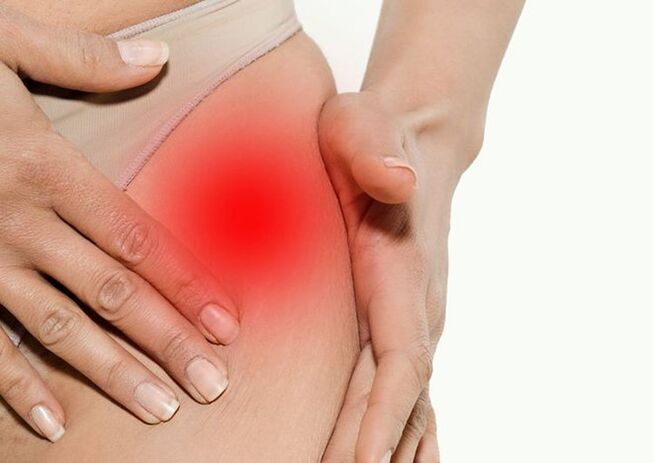
In the last stage of the disease, the bones and joints are affected. Chewing gum formation is typical. Excessive pathological mineralization of them occurs. TBS is extremely rare.
Gumma - a nodule in the tissues, formed during advanced syphilis, destroying the surrounding tissues. The process ends with the formation of rough scars.
Treatment is ineffective, the risk of developing complications in the form of osteomyelitis is high.
Fungal arthritis of the hip
It occurs as a result of prolonged use of antibiotics and with pathologies of the immune system.
People who are infected with HIV or have AIDS are particularly susceptible to fungal arthritis.
Joint pain is constantly present, it has a painful character.
Fungal bone lesions are characterized by a tendency to fistula formation, duration and difficulty of treatment.
Treatment: systemic antifungals.
According to indications, surgery is performed.
Bone and soft tissue tumors
Oncological diseases of the hip joint can be metastases of cancer of a distant organ or occur independently.
- Benign tumors of bone tissue - osteomas.
The foreign formation in the body grows, pressing on the nerves and blood vessels. The clinic is similar to Aphrodisiac Syndrome.
- Malignant bone tumors - osteosarcomas.
The tumor grows rapidly in size, dies and decomposes, spreading the metastases throughout the body.The pain in the hip joints at night is unbearable, it does not stop even after taking NSAIDs or trying anesthesia.
- Mesenchymal tumors are formed by soft tissues. Benigns rarely recur and do not metastasize. Depending on the aggression of the malignant cells, the intensity of the pain varies.
Degenerative diseases of the joint
Coxarthrosis
Osteoarthritis of the hip is a chronic disease characterized by a change in the integrity of the joint surfaces, due to a violation of metabolic processes. It grows very slowly, in several years. First, the cartilage tissue is affected, then the bone tissue and then the deformity of the joint stem and limb is deformed. Appears at the age of 40 years.
Symptoms:
- The hip joint only hurts when you walk.
- Stiffness of movements in TBS.
- As the process progresses, a shortening of the limb length is observed.
- Weakness and atrophy of muscle mass.
- Lameness.
- There is a tingling sensation when walking.
- With a bilateral lesion, a "duck gait" occurs - a transfer from one foot to the other.
Drugs: NSAIDs, vasodilators, muscle relaxants, chondroprotectants, injections of hormonal drugs into the joint cavity.
Local effects: ointments, lotions, compresses.
In the last stage of the disease, surgery is underway.
Osteochondrosis
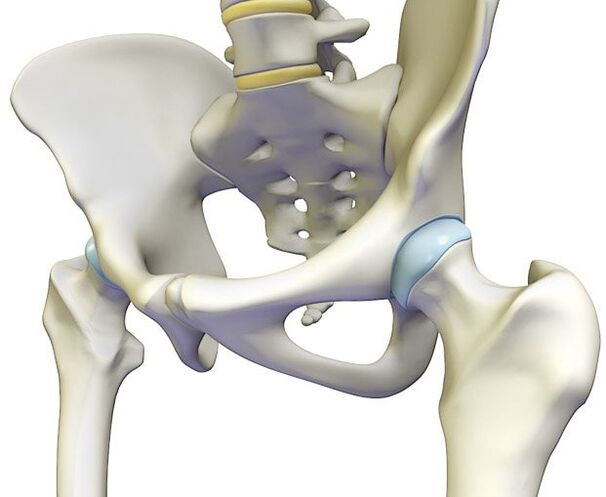
Degenerative changes in the intervertebral discs cause damage to the surrounding tissues.
Symptoms:
- Pain in the lower back that radiates to the hip joint and thigh.
- It is sudden, sharp and sharp. It starts from the lumbar region and the buttocks, goes down to the back of the leg.
- Unilateral localization of pain is more common.
- The patient takes a forced position - lying on a healthy side.
- Possibly reduced sensitivity of the skin of the foot.
The treatment is complex. Anti-inflammatory and analgesic, moderate physical activity (swimming), physiotherapy after the remission of the most acute effects.
With severe pain, it is recommended that you have an anesthetic blockade.
Injuries
Damage
Moderate intensity pain is typical, during active movements its intensity increases. For the first time after a hip joint injury, lameness occurs, which passes quickly.
At rest, the symptoms disappear.
To quickly get rid of the pain in case of injury to the pelvic joint, it is necessary to apply cold to the site of injury: an ice pack or a frozen product.
hip dislocation
It may:
- Congenital. It is the result of unsuccessful childbirth or endometrial development pathologies. The child has uneven gluteal folds and shortening of the limb, possibly a pinched nerve, manifested by spasms. If the dislocation is not corrected in infancy, then later the child may become disabled.
- Traumatic. Signs: acute severe pain, complete cessation of joint function, massive swelling and extensive hematoma appear over the damaged area. It is impossible for the patient to get up from the chair or bed without assistance.
In case of hip dislocation, you should go to the emergency room or hospital immediately.
fractures
The hip joint is formed by strong bones.
The most common diagnosis from this subgroup is a fracture of the surgical neck of the femur. It is mainly administered to women after 60 years.
The cause of such damage is a fall or impact in the TBS area.
The strongest pain is felt, the hip joint pulls and abscesses, movement in it is almost impossible. The upper thigh area swells, an extensive hematoma appears. The injured leg shortens, the patient limps. A characteristic click is heard as you move.
When a fracture occurs, the surrounding tissues are destroyed, which is accompanied by a burning sensation. In the absence of treatment, an inflammatory process can begin here. If the nerve is pinched, you may feel a numbness in the thigh.
The treatment is complex: surgery and medicine.
Specific causes of arthralgia
Piriformis syndrome
By detecting pathological processes in the hip joint area, the surrounding tissues are also affected. A long-term spasmodic opioid compresses the sciatic nerve and its blood vessels, causing a number of symptoms:
- Leg pain in the hip joint area. It goes to the buttocks and the lumbar joint.
- Increased discomfort when relying on the affected foot.
- Compression of the iliac muscle.
- Sudden "lumbago" pain along the nerve.
Etiology: injuries and infectious and inflammatory diseases of the pelvic organs, vertebral pathologies, muscle overtraining, long-term maintenance of abnormal posture.
Medications: NSAIDs, muscle relaxants, analgesics, blood circulation improvers, glucocorticoids.
After the remission of the acute effects, remedial measures can be prescribed: physiotherapy, massage, acupuncture.
Aseptic necrosis of the femoral head
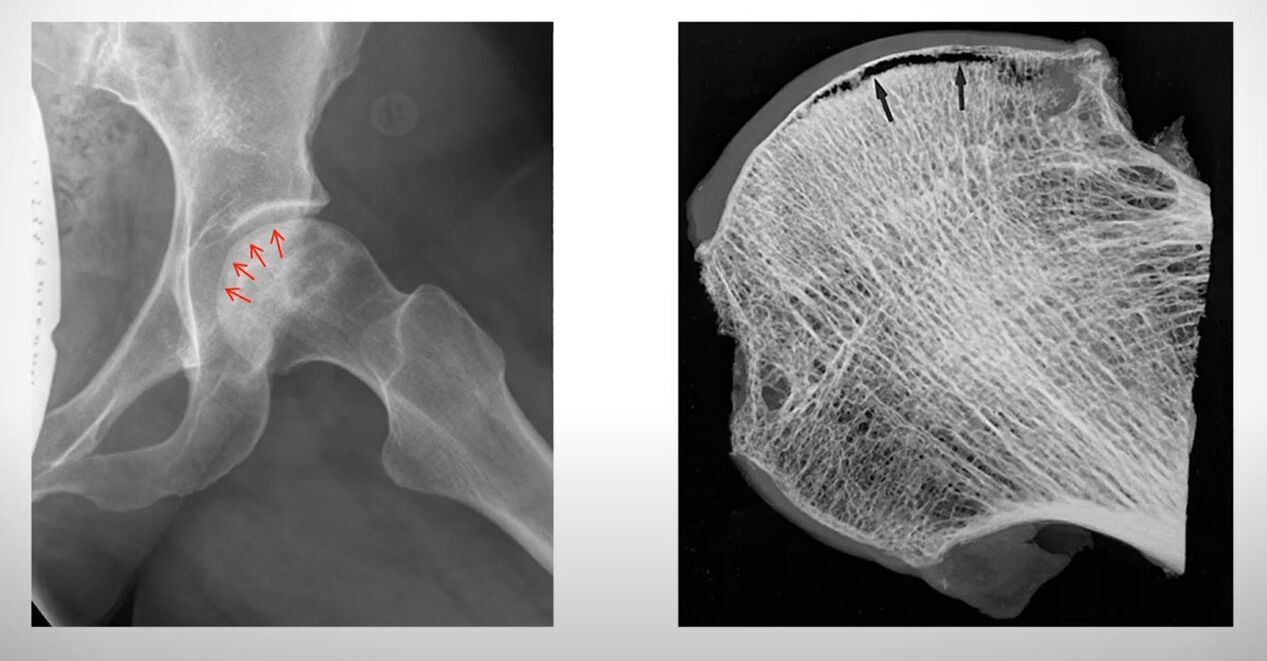
The vast majority appear in young men. The etiology of the disease is ischemia of the upper thigh. With insufficient blood supply to the tissues, their oxygen starvation occurs and their necrosis (necrosis) begins.
Clinical picture: the hip joint hurts and gives the leg and perineum. It is not possible to depend on the injured leg. After a few days, the nerve endings melt and the pain disappears. This is a terrible sign! With necrosis of the deeper layers of bone, the risk of rapidly developing osteomyelitis and sepsis is high.
Treatment is surgery and medication.
Koenig's disease
Anatomical osteochondritis - exfoliation of a small necrotic cartilaginous area from the bone and its protrusion in the articular cavity.
This is a rare disease. Typical for men 15-35 years old.
Patients complain of mild pain in the hip joint. The joint "hangs" when moving.
The treatment is conservative (duration 10-18 months) and surgical. During the surgery, the exfoliated masses are removed, the uniformity (comparability) of the joint surfaces is restored.
Diabetic osteoarthritis
Violation of glucose metabolism leads to circulatory disorders and innervation of all organs. Changes in the hip joint are more often unilateral: on the right, it occurs more often than on the left. The immune response is reduced, which facilitates the infection of the organism.
Clinical picture:
- Swelling of the joint.
- The skin on it is cold to the touch.
There is no pain syndrome in diabetic osteoarthritis!
Treatment consists of careful monitoring of blood glucose levels and timely administration of insulin.
pseudoarthritis
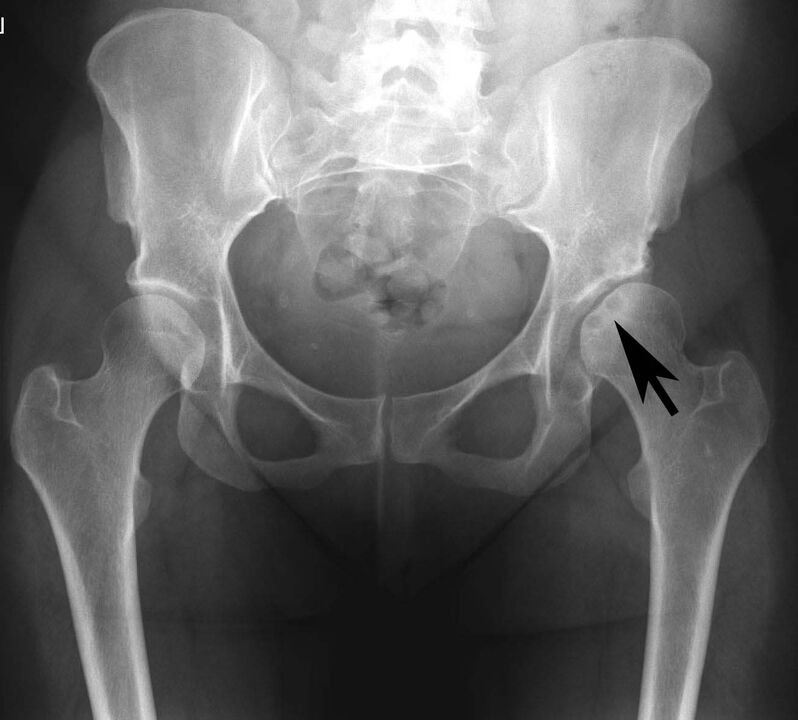
This pathology is the deposition of calcium salts in the articular cartilage.
Doctors associate it with endocrine pathologies: hyperparathyroidism, diabetes, gout, etc.
Symptoms:
- Starting with acute pain in the hip joint.
Various types of calcium salts are known. With some of them (pyrophosphates), there is no pain.
- Movement in it is limited, abduction of the foot to the side is difficult.
- Characteristic are edema and hyperemia.
- Elevated body temperature and fever.
To date there is no specific treatment. The acute attack is stopped with intra-articular administration of corticosteroids and NSAIDs.
Intermittent hydraulic joint
This is a chronic disease, manifested by seizures of increased synovial fluid production. prone to frequent relapses.
It is mainly diagnosed in women 20-40 years old.
The reason is unknown. There are two theories for the occurrence of this disease: it is associated with injuries and is caused by endocrine disorders.
The joint increases in size, becomes stiff.
The attacks go away on their own in 3-5 days.
Medical treatment is ineffective. Relapses occur even after surgery.
articular chondromatosis
This benign metaplastic disease is the replacement of articular collagen with cartilage. The structure of the joint surface changes, as do its properties.
Men are more likely to develop chondromatosis, especially middle-aged and older people.
The reason is unclear.
There is local swelling, limited joint function, stinging at work, arthralgia.
The treatment is only surgical.
Hip pain in children and adolescents
epiphysis
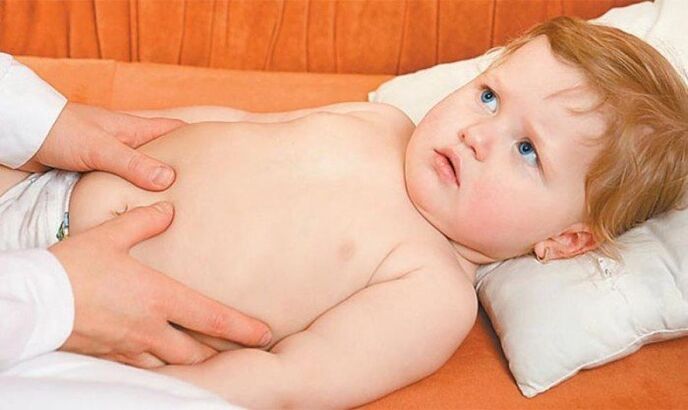
This pathology is most typical for children during adolescence (from 11 to 16 years old). Right now, there is a sharp jump in growth. Due to the weak growth zone, the HBA slips down the neck, causing discomfort to the hip joint.
The child feels pain in the thigh, passing to the groin and knee. Lameness is observed, but dependence on the extremity is maintained.
The disorder is surgically corrected. You should start treatment as early as possible. Otherwise, slipping of the HBA can cause joint growth and inflammation of the joints.
Dysplasia
It is an excessive formation of connective tissue that can replace bone elements. As a result, the solid anatomical structures become plastic, flexible. The ligaments, menisci and tendons become weak. An unstable hip is formed, which is distinguished by frequent dislocations.
Dysplasia is an inherited disease that usually occurs in infants from 3 months to 1 year. Orthopedists can easily deal with correcting foot alignment.
The latent form can appear in adolescence.
If you notice manifestations of clubfoot or deformity of the foot in a child, then you should go to the hospital immediately for an examination of the baby's musculoskeletal system!
The later the dysplasia is identified, the more problematic it is to treat.
Osteochondropathy
This group of diseases includes lesions of bone and cartilage tissue, in which the most charged areas undergo aseptic necrosis.
Etiology: genetic predisposition, hormonal imbalances and infections can cause this pathology.
In 30% of cases the hip joint is affected. These are mainly childhood diseases that are common in adolescents during the developmental exacerbation.
An adult should initially identify the location and nature of the pain, contact a pediatrician, and obtain the necessary information to prevent complications.
Legg-Calve-Perthes disease
The syndrome is characterized by HBK necrosis in children under 15 years of age. The right hip joint is most often affected.
The cause of the pathological condition is the violation of blood circulation in the upper leg by adding cartilage tissue to the procedure.
Clinical picture:
- Initially the head of the femur hurts. As the necrosis progresses, the arthralgia suddenly disappears. This indicates the death of sensitive organ receptors.
- Change in gait - the child begins to limp.
- Traffic on TBS is limited.
- Most of the time one-sided.
Complications: dislocation, coxarthrosis, lower limb deformity, muscle atrophy.
Diagnostic measures
Before prescribing treatment, the doctor should carefully study the complaints, the history and perform an examination.
In case of hip joint disease, the following studies are necessary:
- Laboratory blood tests (with inflammation, the ESR increases and leukocytosis occurs).
- Plain X-ray of the joint in two or more views.
- MRI with or without contrast.
- MSCT. Used to control the presence of sarcoma.
- Osteoscintigraphy. radionuclide method. The most common and informative type of bone tissue examination.
- Ultrasound of the hip joint.
- Densitometry. Required to determine bone density and strength.
If the patient can not sit or stand and it is useless to relieve the pain, then he is immediately sent to the hospital for further surgical treatment.
When to see a doctor urgently
- When there is acute pain when moving the hip joint.
- If it is impossible to support the affected leg.
- Detection of edema of the lumbar and femoral region.
- Redness or bruising in the affected area.
There are folk remedies for relieving pelvic joint pain. Relying on these quick healing tips is not worth it. Without a thorough diagnosis, it is impossible to determine the cause of the arthralgia and self-medication will lead to the development of complications.

































